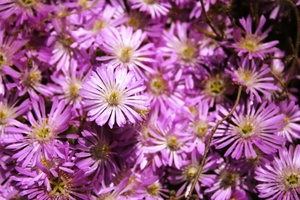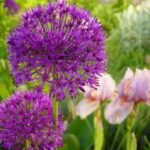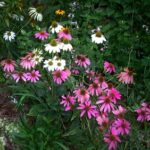Asters are lovely, showy autumn flowers ranging in bright hues of purple, magenta, blue, pink, white and red. You can choose from many lovely varieties including powder puff, pincushion, pompom and double asters. After you plant the perennial asters in your garden they’ll be a bright colorful spot there for years. Asters will also be brightly colored beauties gracing your table. Asters are good for bouquets in vases and other floral arrangements because of their long lasting flowers and strong stalks. Asters’ long blooming time, hardiness and lovely coloring also make them good choices for growing in containers on your patio, porch or deck.
Asters are perennials so they’ll keep their space in the garden for many years. Decide where you want to have the bright flowers in your garden. Asters are easy to grow but they do need to have full sun. Plant them in the spring after frost for bright blooms until the next frost. Asters may also attract hummingbirds and butterflies to your garden.
Many asters have yellow centers made of tiny flowerets. Asters come in many sizes, some dwarfs and some growing to be over four feet tall. The varied sizes of asters look good together in the garden and they’re also good flowers to bring in for bouquets and arrangements. They provide continuous blooms from midsummer to frost.
You may pick asters for bouquets when the flowers are buds or soon after they bloom. When you cut your asters for flower arrangements leave their long stems on them. Put the asters in water right after you bring them inside. If you are bringing in small asters cut their stems a few inches long and use smaller containers or vases. Arrange several kinds of asters together for a bright bouquet. Asters are long lasting flowers in bouquets and arrangements and also good as dried flowers.
Asters grow well from seed and should be planted in a sunny area. If you grow the asters inside and transplant them in early spring it will be easier to arrange the spacing. Plant the aster seeds and cover them with soil according to the directions on the seed packets. Then thoroughly water the area. The aster seeds may germinate within ten days.
Asters can also be propagated by division. The plants should be divided every few years, in the early spring or late fall after they’ve stopped blooming. To divide them you dig up the plants and carefully cut or separate them and their roots into two to four sections. Then you plant those in other locations. You can also grow asters from stem cuttings. Cut them above a node and plant them in pots with rooting medium.
For bigger flowers and better plants enrich the soil with humus, compost, peat moss and fertilizer. The asters should be watered once or twice a week. Remember to fertilize at least once a month. Keep mulch around them to conserve moisture and block weeds. You may have to support the larger asters with stakes. You don’t have to trim the dead flowers but you can. Cover the area with mulch in winter to protect the asters. Add compost and mulch every spring.





